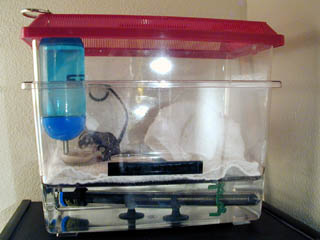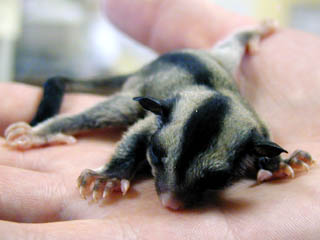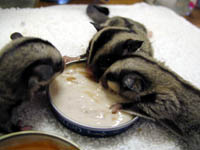|
Raising Joeys
The photo above shows a small brooder. This one has a handtowel in the bottom rather than the bedding mentioned above, but that was before I got tired of doing so much laundry and switched to something easier! You can also use a small covered aquarium with one end sitting on a heating pad set on low, or use one of the stick-on reptile heating pads you can buy at the pet store. The important thing is to make sure they can get away from the heat if they want to, so you don't cook them! Feeding: Homemade glider formula - equal parts of:
Mix that up, adjusting thickness with the cereal or diluted apple juice as needed, and store it in the fridge for no more than 2 days. To feed, warm it to body temperature. I use a dropper to feed them, one of the big fat ones pharmacies give out with baby medicines. It's messy, but it works, and the blunt plastic is less likely to hurt their little mouths. I don't put the dropper IN the mouth; I just touch it to their mouth and let them lap the formula from the end of it. Some do better if you drop formula onto your hand and let them lap it from there -- go with what works. (Make sure your hands are clean!)
One thing that's important: if you're pulling joeys to hand raise as pets, they may not be receptive to being fed at first. DON'T FORCE THE ISSUE. This is when they are developing their sense of what human beings are. You want to make a good impression, or you can ruin them as pets. If the baby refuses and crabs violently even after tasting the formula, put him back in his pouch and wait a couple hours to try again. If by the 3rd or 4th try he still won't eat, put him back with his parents. You can try again in a few days. Maybe he will be more willing then, or maybe he's just not cut out to be a "people" glider. Each time you feed a young joey, rub his belly gently with a warm damp cloth to stimulate him to defacate. Once he starts doing it on his own you won't need to do this any more.
This is also when I add a small dish of water. For that I use a small ceramic bird food cup - too heavy for them to tip over easily, but too small for them to crawl into and drown. (They can crawl into it, but they'd have to work hard to get their head under the water because their body fills the whole cup.) Weaning: Now is the time to teach your babies to eat a variety of foods. If you can get the idea of trying new things across to them now, you will be 'way ahead of the game later on. In the evening, make 3 or 4 tiny bowls of different foods to put in the brooder. What I do is mix a little of the formula with different things - half and half at first, then less formula. The familiar formula taste and consistency encourages them to go ahead and try the new things. Here are some ideas:
Rotate the foods so they have a different combination each night, but always give them at least one thing you know they will eat. Starving them into submission so they'll eat what you want them to eat isn't the right approach. :) Keep a dish of water in the brooder, but also add a water bottle if that's how you want them to drink eventually. Never take away the water dish until you have SEEN them use the bottle, though. Gliders dehydrate quickly, so don't take any chances! As they accept the soft foods more readily, gradually decrease the amount of formula you mix in until finally they're eating them without formula. (It's still okay to give them formula too; in fact continuing to dropper feed them a couple of times a day is a great way to socialize and bond with them.) Once the soft foods are going down well, add a dish of Pretty Bird softbill pellets -- they are baby-sized and have a yummy fruity smell, and young joeys quickly learn to chew on them. It's important to have crunchy food in their diet, for the health of their teeth; otherwise you can end up dealing with tooth abcesses and things later on. Also start trying small pieces of fruits and veggies - berries, grapes, melon, apples, oranges, peas, corn, carrots, etc. For protein use small pieces of cooked chicken or turkey (no salt) and boiled egg. Use your imagination. Try lots of things, and rotate so there's always a new combination of things to taste. For the first few months, you will waste a lot of food. Just get used to the idea and don't worry about it. It's really important to give them lots and lots of different things to try. Even if they don't touch a particular food the first few times, keep trying because eventually they will taste it, and they might decide they like it. Don't give them the same things every night, even if they like them, so they won't get tired of them and stop eating them. The only things I give every night are Leadbeater's mix (they never get tired of it!) and monkey biscuits, but the monkey biscuits are soaked in a different flavor of juice every night so they don't get boring. I keep them in the brooder until they are 6 weeks old and able to generate enough body heat to keep themselves warm. When you do move them to a cage, though, make sure they have a place to snuggle and get warm, like a pouch or a small nestbox with warm soft bedding. Make sure it's small enough; if they have a large nestbox they won't be able to generate enough body heat to warm the whole thing. |
 The first thing to know and remember about joeys is that they are very susceptible to chills, so you need to make sure you keep them warm. Mine are in a pouch under my shirt during the day, and in a brooder at night. The brooder is made from two Kritter Keepers of the same size. The bottom one has about 2.5 inches of water in it, and a submersible aquarium heater. The top one sits down into it so the water climbs partway up the sides. I put Care Fresh bedding in it, about 1-2 inches deep (4-5 layers of paper towels is okay instead), and a clean crumpled up washcloth at one end. A thermometer laying on the bedding should read right around 89-90 degrees farenheit. With the bedding and the washrag, the babies can decide how close to the heat they want to be. Sometimes I find them curled up on the plastic bottom with the bedding pushed away, and sometimes they sprawl on top of the washrag.
The first thing to know and remember about joeys is that they are very susceptible to chills, so you need to make sure you keep them warm. Mine are in a pouch under my shirt during the day, and in a brooder at night. The brooder is made from two Kritter Keepers of the same size. The bottom one has about 2.5 inches of water in it, and a submersible aquarium heater. The top one sits down into it so the water climbs partway up the sides. I put Care Fresh bedding in it, about 1-2 inches deep (4-5 layers of paper towels is okay instead), and a clean crumpled up washcloth at one end. A thermometer laying on the bedding should read right around 89-90 degrees farenheit. With the bedding and the washrag, the babies can decide how close to the heat they want to be. Sometimes I find them curled up on the plastic bottom with the bedding pushed away, and sometimes they sprawl on top of the washrag.
 For really young gliders (2 weeks OOP or less) you will need to feed 4 to 6 times a day. Let the baby tell you how much and how often; you'll get a feel for it quickly. For the first feeding, get the baby in a comfortable position in your left hand (assuming you're right handed). This can be harder than it sounds, since they want to bury their heads and it's really hard to get a firm grip on them, but be patient until you find a position the baby is happy with so you have time to show them what you're trying to do. You'll get the hang of it, and so will they. Once they're in position, gently pull their lower lip down and put a touch of formula on their teeth so they can taste it. Usually that's all it takes to get them eagerly eating from the dropper.
For really young gliders (2 weeks OOP or less) you will need to feed 4 to 6 times a day. Let the baby tell you how much and how often; you'll get a feel for it quickly. For the first feeding, get the baby in a comfortable position in your left hand (assuming you're right handed). This can be harder than it sounds, since they want to bury their heads and it's really hard to get a firm grip on them, but be patient until you find a position the baby is happy with so you have time to show them what you're trying to do. You'll get the hang of it, and so will they. Once they're in position, gently pull their lower lip down and put a touch of formula on their teeth so they can taste it. Usually that's all it takes to get them eagerly eating from the dropper.
 As soon as their eyes are open, you can start teaching them to eat on their own so they can eat during the night if they are hungry, but keep giving them dropper feedings during the day too. Just put a tiny dish of formula in the brooder where they can find it. You will know when they do, because they tend to swim in it. :) The smaller the dish the better, because of this. I use little plastic condiment containers I buy at a wholesale grocery store. They're about 1.5" in diameter and 1/2" deep. That way I can just throw them away after using them, instead of washing them every day. Baby food jar lids are good too.
As soon as their eyes are open, you can start teaching them to eat on their own so they can eat during the night if they are hungry, but keep giving them dropper feedings during the day too. Just put a tiny dish of formula in the brooder where they can find it. You will know when they do, because they tend to swim in it. :) The smaller the dish the better, because of this. I use little plastic condiment containers I buy at a wholesale grocery store. They're about 1.5" in diameter and 1/2" deep. That way I can just throw them away after using them, instead of washing them every day. Baby food jar lids are good too.
